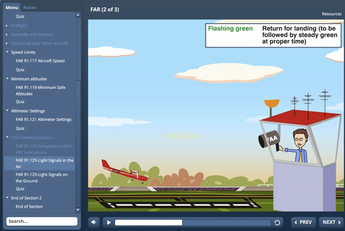|
Required Aircraft Documents
An easy way to remember what documents are required to be onboard an aircraft is to remember “AROW” A - Airworthiness Certificate R - Registration O - Operating Limitations W - Weight & Balance The Airworthiness Certificate is issued by the FAA and deems an aircraft’s design to be legal for operation. It remains valid for as long as the airplane meets its approved type design and is maintained correctly. In other words, it does not have an expiration date. The Registration certificate is similar to the registration of your car. The registration includes the owner’s information as proof of ownership, and expires every 3 years (to the month). An aircraft’s tail number, or “N” number, is the aircraft's registration number. It is required to be visible on the outside of the aircraft, and the paper registration document is also required to be onboard. Both the Airworthiness Cert and the Registration are often kept together in a clear pocket somewhere inside the airplane. The Operating Limitations of the airplane must be on board. This includes, but is not limited to, placards and signs indicating limitations, gage indications (white arc, green arc on the Airspeed Indicator, etc.), and the Pilot’s Operating Handbook (aka “the POH”) or Flight Manual. The POH should be within reach of the pilot at all times during the flight, as it contains useful information on operation of the aircraft, as well as emergencies. Weight and Balance documents are necessary to be on board so that the pilot can calculate the airplane’s Center of Gravity and assure that the aircraft - loaded with fuel, passengers, bags, and the pilot - is not going to takeoff heavier than its legal limit.
This topic and other similar FAR-related topics can be kind of a dry grind when learning or reviewing them. You may want to check out this interactive course, which includes practical explanations, videos, and animations - all of which can help make this subject a little more interesting. Or, if you are studying for your biannual flight review, this Flight Review course bundle includes the FAR course as well as a few others that will provide you all the review you need for a successful flight review. Good luck!
3 Comments
3/2/2021 03:47:10 pm
If the aircraft is to be flown outside the borders of the U.S., an aircraft radio station license is also required.
Reply
Source
7/27/2023 12:44:41 pm
I wish they would've cited the FARs here as well. As far as I'm concerned, this is an example of a deficiency in training given by this flight school, and I'd expect more to come to light.
Reply
Leave a Reply. |
|
- Home
-
Flight Instruction
- Private Pilot Flight Training
- Remote Pilot Part 107 Drone UAS Training
- Sport Pilot Flight Training
- Instrument Rating Flight Training
- Commercial Pilot Flight Training
- Multi-Engine Flight Training
- CFI Flight Training
- ATP Flight Training
- Bend Flight Training
- Flight Simulators
- Flight Review
- Paragliding and Paramotoring
- Private Pilot Ground School
-
Courses & Books
- Learning Center
- Contact
- Pilot Resources
- Our Goal
- News
- Ferry Pilot Services
- Contract Pilot Services
- Oregon Flight Instructor Jobs

